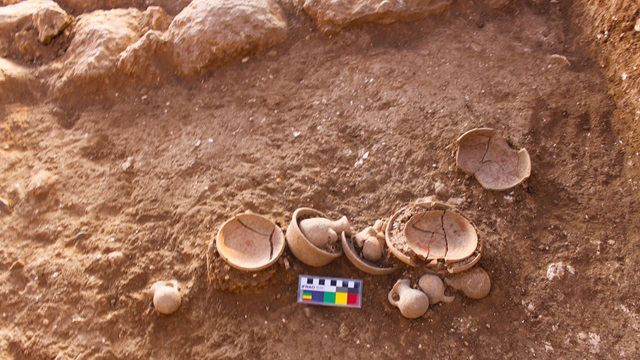
Temple offerings – miniature as well as food serving vessels, and a shell of marine mollusc, Tonna galea found in one of the temples (Credit: Prof. Aren Maeir)
Researchers from Bar-Ilan University analyzed seeds and fruits found in southwestern and say they shed light on the ritual practices of the ancient Philistines, the Biblical enemies of the Israelites. The research comes from experts in the relatively new field of Archaeobotany.
Archaeobotany is the scientific study of past human-plant interactions through the analysis of preserved plant remains from archaeological sites. By studying the remains of macrofossils (seeds, fruits, nuts, wood, and other larger plant parts), microfossils (pollen, spores, and phytoliths – microscopic silica bodies produced by plants) archaeobotanists can learn about a variety of things. This includes the local development of agriculture and what people ate in ancient times, among others.
Dr. Suembikya Frumin, under Prof. Ehud Weiss’s supervision, studied Philistine plant use in their temples as part of her PhD project. Together with Dr. Amit Dagan, Maria Eniukhina, and Prof. Aren Maeir, they delved into the plant assemblages discovered within the temples’ precincts, uncovering a wealth of information regarding the significance of various plant species in Philistine religious rituals. Through meticulous examination and quantitative and qualitative analysis of the types of plants used, the timing of their harvest, modes of offering, and potential symbolic significance, the researchers pieced together a clearer picture of the Philistine approach to spirituality.
Will you offer us a hand? Every gift, regardless of size, fuels our future.
Your critical contribution enables us to maintain our independence from shareholders or wealthy owners, allowing us to keep up reporting without bias. It means we can continue to make Jewish Business News available to everyone.
You can support us for as little as $1 via PayPal at office@jewishbusinessnews.com.
Thank you.
The enigmatic Philistine culture, which flourished during the Iron Age (ca. 1200-604 BCE), profoundly affected the southern Levant’s cultural history, agronomy, and dietary customs. More than a quarter century of Gath of the Philistines and the home of Goliath, has provided a unique window into the world of this ancient civilization. In the systematic excavation project of the temple area in the lower city of Gath, a team from Bar-Ilan University led by Prof. Aren Maeir (archaeology) and Prof. Ehud Weiss (archaeobotany) has overseen the reconstruction of the plants used in Philistine rituals.
While many aspects of Philistine culture are well-documented, the specifics of Philistine religious practices and deities have long remained shrouded in mystery. The study by Frumin et al. on “Plant-Related Philistine Ritual Practices at Biblical Gath,” recently published in Scientific Reports, contributes valuable new data to our understanding of the Philistine’s ritual practices. The discovery of numerous plants in two temples unearthed at the site unraveled unprecedented insights into Philistine cultic rituals and beliefs – their temple food ingredients, timing of ceremonies, and plants for temple decoration.
Dr. Suembikya Frumin, manager of the Archaeobotany Laboratory at Bar-Ilan University and the study’s lead researcher, noted, “One of the most significant findings is the identification of earliest known ritual uses of several Mediterranean plants, such as the lilac chaste tree (Vitex agnus-castus), crown daisy (Glebionis coronaria), and silvery scabious (Lomelosia argentea). These widespread Mediterranean plants connect Philistines with cultic rituals, mythology and paraphernalia related to early Greek deities, such as Hera, Artemis, Demeter, and Asclepios. In addition, plants with psychoactive and medicinal properties in the Philistine temples reveal their use for cultic activities. The study revealed that the Philistine religion relied on the magic and power of nature, such as running water and seasonality, aspects that influence human health and life.”
Moreover, analysis of the temples’ seeds and fruits provided valuable insights into the timing of rituals, with the importance of the early spring for temple rites, and the date of the final utilization of the temples — and their destruction by Hazael of Aram – which occurred in late summer or early fall. The seasonal aspect of Philistine religious practices underscores their deep connection to the natural worlds and the cycles of agriculture.
Prof. Ehud Weiss, Director the Archaeobotany Laboratory at Bar-Ilan University and co-author of the study, commented, “Our findings challenge previous understandings of Philistine ritual practices and offer a fresh perspective on their cultural practices, and the connections between Philistine culture and broader Mediterranean religious traditions. By examining the plants they used in ritual contexts, we better understand how the Philistines perceived and interacted with the world around them.”
Furthermore, the study proposes intriguing parallels between Philistine and Aegean ceremonial practices. The discovery of loom weights (an apparatus used for fabric production) within Philistine temples, a common feature in Aegean cult locations associated with Hera, further strengthens the hypothesis of cultural exchange and influence between the two regions.
“These findings open up new avenues for research into the cultural and religious interactions between the Philistines and neighboring regions,” added study co-author Prof. Aren Maeir, of Bar-Ilan University’s Martin (Szusz) Department of Land of Israel Studies and Archaeology, who has directed the excavations at Tell es-Safi/Gath for more than 25 years. “By employing advanced quantitative and qualitative analyses of plant assemblages, we have deepened our understanding of ancient cultic practices and their significance in the broader Mediterranean world.”



